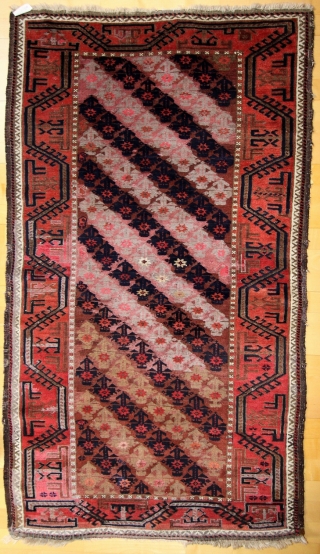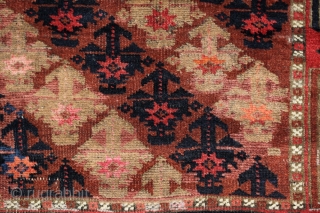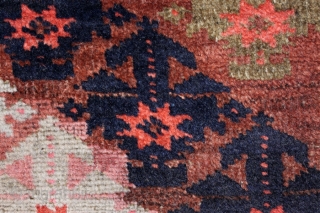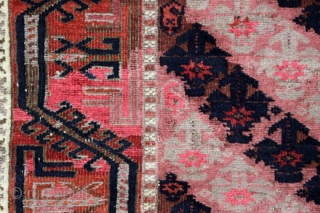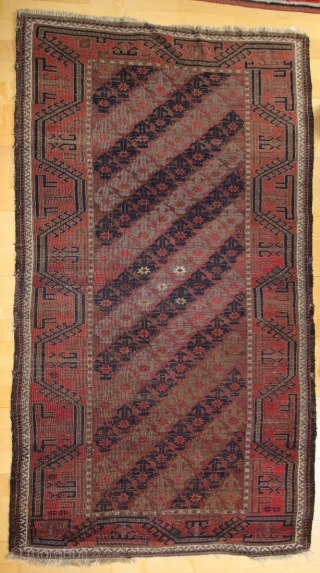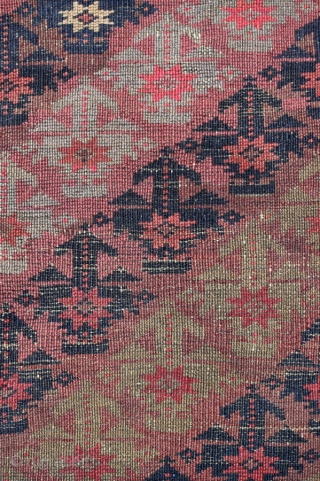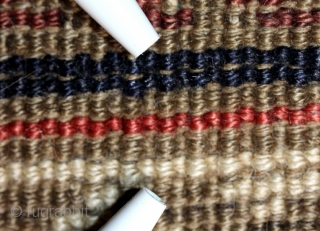Back
Baluch rug; study piece; 104 x 183 cm (3`5“ x 6`0“); between 1870 and 1900; diagonal shrub design known from Taimani or "Doktor-i-ghazi"; shrubs colour is in every second diagonal an ugly gray in two different shades.
In my eyes the gray colour is an Aniline colour named Fuchsine, was originally purple/magenta and turned into gray during being exposed to the light/sun. Aniline colours appeared earliest about 1870 in the region where Baluch tribal lived and disappeared around 1900. So this type of coulour is a good time indicator for the period in which the rug has been produced.
Normally Fuchsine was used in Baluch rugs very rarely, e.g. as a single central knot in a motive , it was expensive as nomads couldn`t produce Fuchsine coloured wool themselves. In this rug Fuchsine has been used very generous which indicates either that weavers were very rich to afford such a big quantity of Fuchsine dyed wool, or it was already produced from “villagers”, maybe as an early export product?
Interesting too that there is in the lower part of the rug another shading of gray than in the upper part, this in a way that one has to suppose that the weaver used two differ lots of wool which were made with different coulouration procedure.
The background colour around the Fuchsine coloured shrubs has also different colour. i can`t find an explication for that, maybe is a chemical reaction to the aniline Fuchsine?
Otherwise rug is in very good condition, soft and gloss wool, original Shirasi and reduced Kilim ends.Sme knotes are made with 3 ply yearn.
For sure this rug would be a good addition for a nice collection as it is well done in a good design. Wish they didn`t use this at that time expensive and rare, but now ugly colour……
price:
Please ask
- Home
- Antique Rugs by Region
- Category
- Profiles
- Post Items Free
- Albums
- Benaki Museum of Islamic Art
- Budapest: Ottoman Carpets
- Gulbenkian Museum
- Islamic Carpets. Brooklyn
- Islamic Textiles. Brooklyn
- Konya Museum: Rugs
- MKG, Hamburg
- MMA: Caucasian Carpets
- MMA: Mamluk Carpets
- MMA: Mughal Indian Carpets
- MMA: Ottoman Carpets
- MMA: Safavid Persian Carpets
- MMA: Turkmen Rugs
- McCoy Jones Kilims
- Ottoman textiles. Met
- Philadelphia Museum
- Rugs and Carpets: Berlin
- Seljuqs at the Met
- TIEM, Istanbul: Carpets
- V&A: Classical Carpets
- Vakiflar Carpets: Istanbul
- Baluch Rugs: Indianapolis
- Gallery Exhibitions
- Jaf an Exhibition
- Alberto Levi Gallery
- Andean Textile
- Christie's London: 2016
- Francesca Galloway
- HALI at 40
- ICOC Washington, DC 2018
- Jajims of the Shahsavan
- London Islamic Week April, 2018
- Mongolian Felts
- Navajo Rugs: JB Moore
- Persian Piled Weavings
- SF Tribal & Textile Art Show 2020
- SF Tribal 2019
- Sotheby's: C. Alexander
- Turkish Prayer Rugs
- Turkmen Main Carpets ICOC 2007








